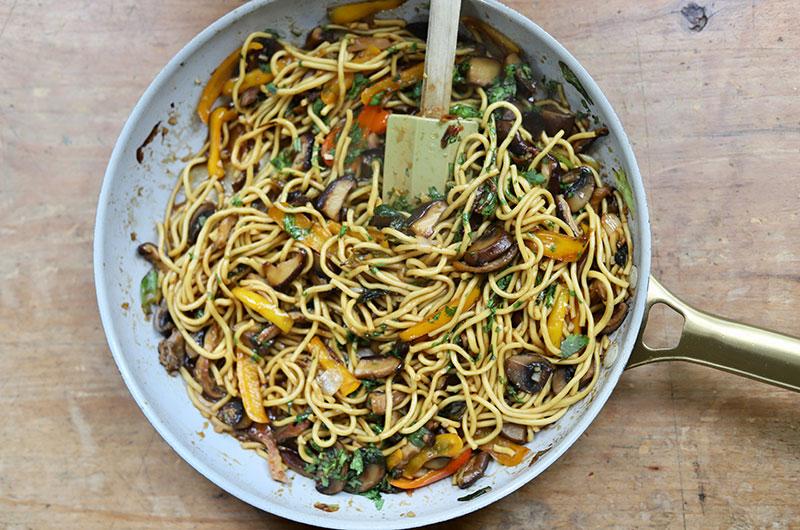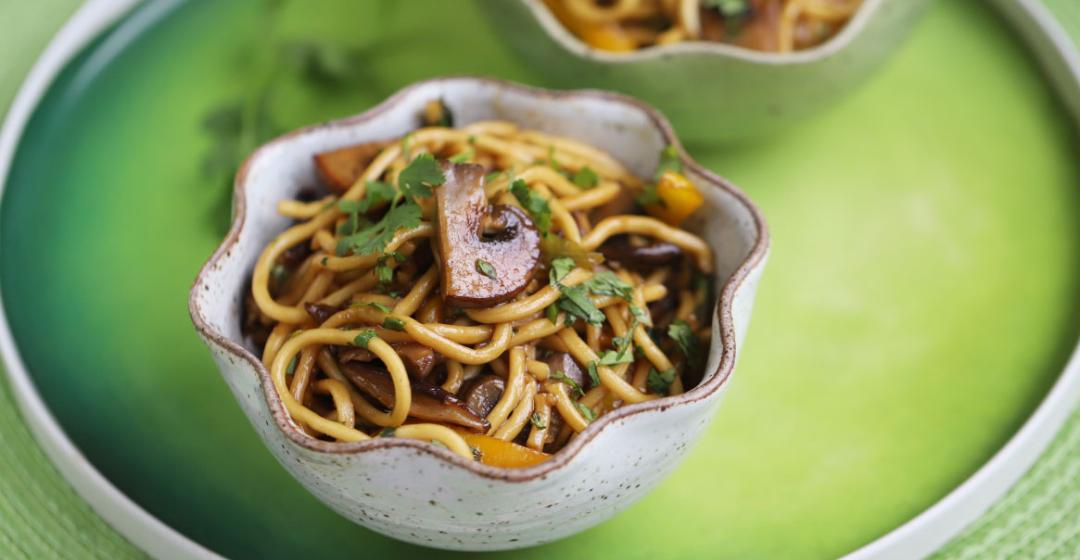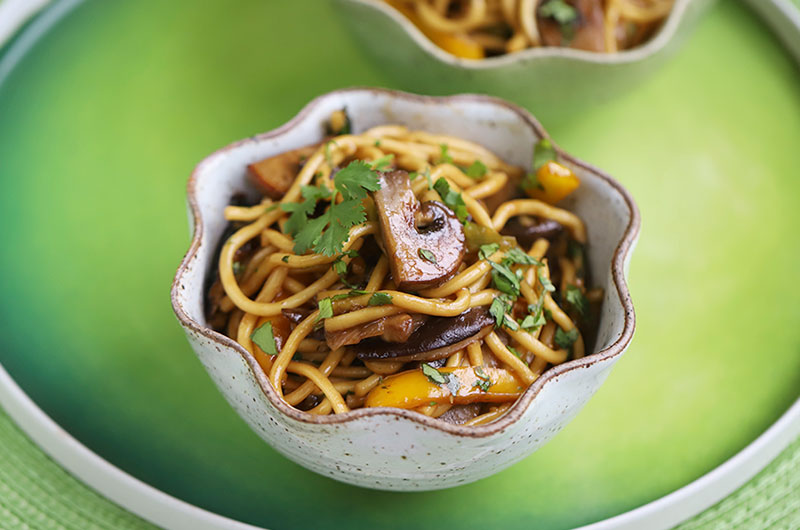Mushrooms and noodles were made to go together. Add ginger, garlic, and a heady sauce, and you’ve got a deeply flavorful main or side dish. To get the most out of your mushrooms, slice them thickly (if they are large, cut them in half first) and be sure to brown them well. They will first have to soften up and release their moisture, but then they’ll begin to brown and take on a richer flavor.
I love Chinese egg noodles (lo mein), which you can buy in the produce section at Cronig’s Market. I think they are really the best noodle for a dish with a sauce like this, but your next best bet is probably a dried linguine or udon. Other fresh egg noodles are a little too delicate.

You will need some Asian condiments to make the sauce, but they are all things that are available at grocery stores and that you will use again. Don’t try to make this without them, since they contribute a lot of umami.
Tip: if you don’t have a lid for your skillet, use a sheet pan.
I do not wash my mushrooms as I do not want them soaked with water. If there is excess dirt on a mushroom, use a pastry brush or a damp cloth to remove it.
I’m calling for about 5 cups of thickly sliced mushrooms in the ingredient list. Pack those cups (in other words, be generous) and if you like, weigh your yield. About 11 to 12 ounces of sliced mushrooms works well here.
Serves 2 as a main dish, 4 as a side
- Kosher salt
- 8 ounces fresh lo mein (egg) noodles
- 2 teaspoons toasted sesame oil
- 2 tablespoons low-sodium tamari or soy sauce
- 2 tablespoons hoisin sauce
- 2 tablespoons oyster sauce
- 1 tablespoon mirin (rice wine)
- ½ to 1 teaspoon Asian chili-garlic paste
- ½ cup water
- 3 tablespoons vegetable, grapeseed,
- or other neutral oil
- 2 cups thickly sliced (about 3/8-inch thick) cremini mushrooms
- 2 cups thickly sliced (about 3/8-inch thick) stemmed shiitake mushrooms
- 1 cup thickly sliced oyster mushrooms (or other mushroom)
- 1 cup thickly sliced scallions (cut on the bias into pieces, roughly 3/4-inch)
- ½ cup thinly sliced bell peppers
- 1 tablespoon chopped fresh ginger
- 1 tablespoon chopped fresh garlic
- ¼ cup roughly chopped fresh cilantro (or a combination of cilantro, mint, and basil or Thai basil)
1. Bring a large pot of salted water to a boil. Add the lo mein noodles and cook until just tender, about 3 minutes. Drain in a colander, rinse briefly, and let dry a bit. Transfer to a bowl and toss with a big pinch of salt and 1 teaspoon of the sesame oil.
2. In a glass measuring cup, whisk together the tamari, hoisin, oyster sauce, mirin, chili-garlic paste, ½ cup of water, and the remaining teaspoon of sesame oil. Set aside.
3. In a large (12-inch) nonstick skillet that has a lid, heat 2 tablespoons of the vegetable oil over medium-high heat. Add the mushrooms and 1 teaspoon salt and cover loosely. Cook, stirring, until the mushrooms have softened and are beginning to brown (they will have shed some liquid), about 4 to 5 minutes. Uncover, add the remaining tablespoon of oil, scallions, peppers, and a pinch of salt. Continue cooking (uncovered) over medium-high heat, stirring frequently, until all or most of the mushrooms have some nice browning and the peppers and scallions are softened and beginning to brown, 4 to 5 more minutes.
4. Add the ginger and garlic to the skillet; stir well until fragrant, typically about 30 seconds.
5. Stir in the noodles and the vegetables. Re-whisk the liquid ingredients and add them to the skillet. Bring to a simmer. Cook, stirring, until the noodles are heated through and the sauce is reduced and thickened (there should be just a bit of liquid on the bottom of the pan; the remainder will be well-distributed and absorbed by the noodles and vegetables), about 2 minutes.
6. Remove the skillet from the heat, stir in most of the chopped herbs, and transfer to a serving platter or shallow bowls. Garnish with the remaining herbs.








